Understanding Bathtub Refinishing: Limitations and Practices
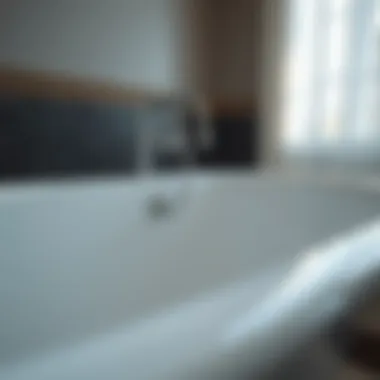
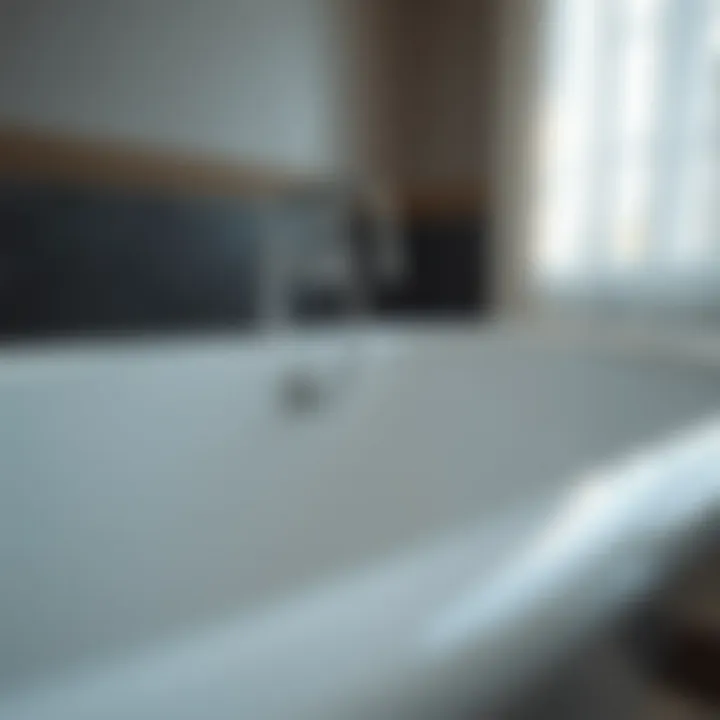
Intro
Bathtub refinishing can be a bedrock cornerstone of rejuvenating your bathroom without embarking on a full renovation. Homeowners grappling with aging or unsightly surfaces often consider this option, but the nuances surrounding frequency and sustainability come into play. Refinishing not only spruces up the aesthetic but provides a shield against deterioration. However, one might wonder: how many times can a bathtub be refinished before it starts to show signs of wear and tear or might lose its luster?
In this guide, we will unravel the layers of limitations inherent in bathtub refinishing. We will also dive into best practices that prolong its lifespan while ensuring that your tub maintains both functionality and beauty. Armed with the right knowledge, the homeowners can transform their bathing space into a retreat they never want to leave.
Current Trends
When it comes to bathtub refinishing, staying abreast of current styles and color palettes helps homeowners make more informed choices that complement their homes and personal tastes.
Color Palettes
The color of your refinished tub can radically alter the bathroom's ambiance. The trend is leaning towards softer hues, which provide a soothing backdrop. For instance, soft pastels like mint green and powder blue are gaining traction, allowing for a calm bathing experience. On the bolder side, deep navy or charcoal colors are favored for those wanting to make a statement, seamlessly fitting into modern, chic bathroom decors.
Popular Styles
When discussing popular styles of tubs, the freestanding models are quite the talk of the town these days. These tubs not only offer luxurious aesthetics but also present versatile refinishing options. From vintage clawfoot to contemporary minimalist designs, refinishing can enhance the tub's historic appeal or modern vibe.
Common refinishing finishes are high-gloss, satin, or matte, each offering its own unique flair. Homeowners can experiment with these finishes, paired with trendy tile or countertop colors to create a coherent style throughout the bathroom. Refinishing enables one to choose a style that not only reflects personal taste but also increases the home's value.
Visual Ideas
Discussing visual improvements can paint a clearer picture and inspire confidence in refinishing projects. Homeowners might consider creating a personal gallery of styled spaces that showcase the potential transformations that are achievable.
Before-and-After Transformations
Imagining the outcome is sometimes as hard as believing it. By looking at before-and-after images, one can truly appreciate the impact of refinishing. A dull and chipped bathtub can be brought to life with a simple refinishing job. The sleek, polished surface adds a touch of elegance that makes any bathroom feel majestic.
“A refinished bathtub not only serves its purpose but elevates the entire aesthetic of the space.”
Transformations often illustrate the magic of refinishing—a small investment leading to a big payoff, both in enjoyment and home value. Homeowners should not underestimate the impact a well-finished tub can have, not just on style but also in cultivating a serene environment that invites relaxation.
By carefully considering these elements, homeowners can make decisions that harmonize with their aspirations for bathroom decor and functionality.
Understanding Bathtub Refinishing
Bathtub refinishing has become a popular choice for homeowners looking to revitalize their baths without the hefty price tag of a full replacement. Understanding this process is crucial because it allows one to grasp its implications on the long-term aesthetics and functionality of the tub. While refinishing can breathe new life and shine into an old fixture, several factors come into play, dictating how often this process can be repeated without compromising the integrity of the bathtub.
The benefits of a well-refinished bathtub can be invaluable. A freshly resurfaced bath can enhance the overall appeal of a bathroom, increasing a home's market value significantly. Many might not realize that their tub's material can affect not only the refinishing process itself but also how often they need to refinish. With options ranging from porcelain to fiberglass to cast iron, each material exhibits different wear patterns and durability after refinishing.
Overall, a clear understanding of bathtub refinishing helps you make informed decisions for bath maintenance. Let’s delve deeper into defining what this process entails and the various advantages it offers.
Defining Bathtub Refinishing
Bathtub refinishing, sometimes also called resurfacing, is the process of applying a new coating to an existing bathtub, restoring its original appearance and extending its lifespan. This typically involves sanding down the surface to remove any old finish, repairing any damage, and then applying a high-quality epoxy or acrylic coating. It’s essential to understand that this isn’t just a cosmetic fix; it is a comprehensive approach to giving a worn-out tub a new lease of life.
Here are a few key pointers to keep in mind regarding the process:
- Preparation is Key: Before starting, thorough surface preparation is required to ensure proper adhesion of the new coating.
- Application Techniques: Professionals often use spray techniques rather than brushes, leading to a smoother finish.
- Drying Time: The refinished surface usually requires adequate drying time, which may vary based on environmental conditions.
Benefits of Refinishing
Choosing to refinish your bathtub offers several benefits that go beyond simply improving its appearance. Here are some significant advantages:
- Cost-Effective: Refinishing is generally much less expensive than replacing the entire bathtub.
- Time Efficient: The refinishing process can often be completed in just a few hours, with a short curing time compared to the full renovation process.
- Environmentally Friendly: By opting to refinish instead of replace, you reduce waste, as the old tub remains intact.
- Increased Home Value: A well-maintained and visually appealing bathroom can enhance your home’s value, making refinishing a worthwhile investment.
Furthermore, refinishing can also be customized to suit your tastes, from color selection to finish texture. With proper maintenance, a refinished tub can last for many years, making it a smart choice for any homeowner.
"Understanding tub refinishing is essential not just for aesthetic improvements but also for informed long-term care decisions."
In summary, understanding bathtub refinishing is more than a cursory glance; it involves grasping the nuances of processes, materials, and advantages. Being well-informed is vital for homeowners looking to maintain and enhance their bathroom's appearance and functionality.
Factors Influencing Refinishing Frequency
The frequency with which a bathtub can be refinished varies significantly based on several important factors. Understanding these elements not only guides homeowners in making informed decisions but also provides a clearer picture of how to maintain the integrity and visual appeal of their bathtubs over time. Several considerations come into play, including the material composition of the bathtub, the initial quality of the refinishing process, how often the tub is used, and the maintenance practices employed post-refinishing. These factors collectively shape the bathtub's lifespan and aesthetic, making it crucial to evaluate them thoroughly.
Material Composition of Bathtubs
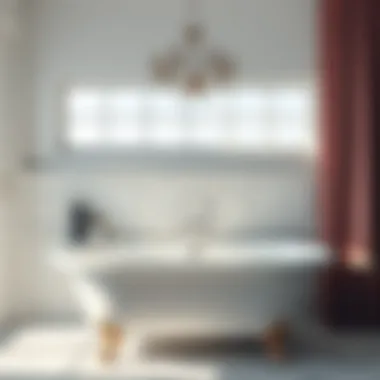
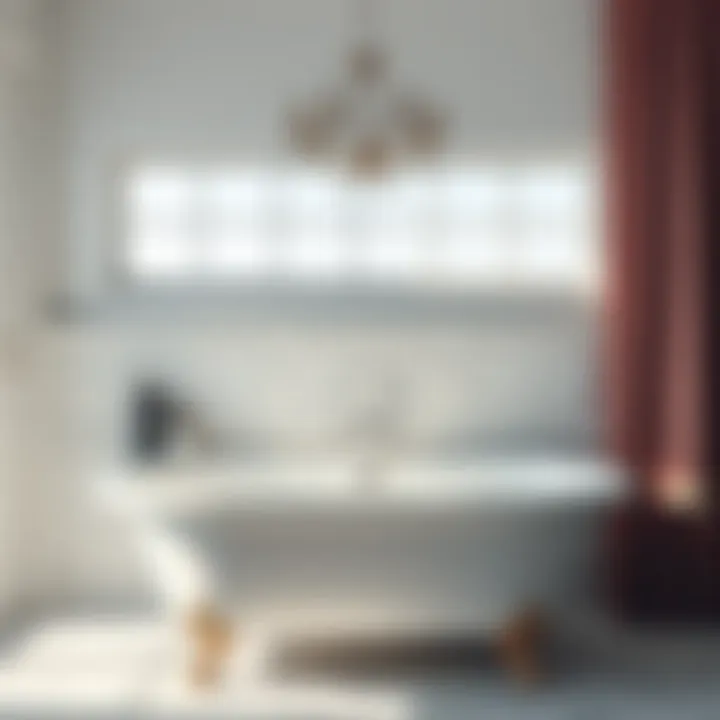
The material that a bathtub is made from plays a vital role in its durability and needs for refinishing. Different materials present unique characteristics that contribute to the overall refinishing frequency. Below, we break down three common bathtub materials: porcelain, fiberglass, and cast iron.
Porcelain
Porcelain is often revered for its glossy finish and durability. This material, made from baked clay and minerals, can give bathtubs an attractive appearance while providing a strong surface.
One noteworthy aspect of porcelain is its capacity to withstand high temperatures and resist water damage. However, it is particularly sensitive to chips and scratches. Once damaged, it often requires refinishing sooner than other materials. Therefore, homeowners must be aware that although porcelain looks appealing and can last a long time, it demands regular maintenance and careful use to prolong the refinished surface's life.
Fiberglass
Fiberglass bathtubs are lighter and usually less expensive than their porcelain counterparts. This material allows for more design flexibility, which many homeowners appreciate. Additionally, fiberglass can be easier to install due to its lightness.
However, fiberglass may not hold up as well against wear and tear. It can fade, scratch, and become brittle over time, which could necessitate refinishing more frequently. If you have a busy household, a fiberglass tub might require more refinishing work compared to other, sturdier options.
Cast Iron
Cast iron bathtubs are known for their strength and long life. Coated with enamel, they are less prone to both scratches and dents compared to porcelain and fiberglass. A well-maintained cast iron tub can last decades with minimal refinishing needs, making it a smart investment for many homeowners.
However, despite their durability, cast iron tubs are significantly heavier, which means installation can be more complex. Furthermore, if the enamel begins to chip, refinishing should be undertaken promptly to avoid further damage to the cast iron underneath.
Quality of Initial Refinishing
The quality of the initial refinishing job can greatly determine how often a bathtub can be refinished again. This is another aspect every homeowner should be mindful of; taking shortcuts or using subpar materials can lead to more frequent refinishing.
Professional vs. DIY
When it comes to refinishing, hiring a professional can be contrastingly beneficial compared to a DIY job. Professional services usually use higher quality materials and techniques tailored to different bathtub types, resulting in a more even and durable finish. Conversely, DIY refinishing may be tempting but often leads to uneven surfaces, requiring earlier refinishing down the line.
Moreover, specialized equipment used by professionals often provides a more permanent solution, while DIY methods may only serve as temporary fixes. This results in making a professional refinishing job the more economical option in the long run, despite the higher upfront cost.
Material Quality Used
The choice of refinish material matters significantly as well. High-quality materials and coatings can resist scratches, moisture, and chemicals, ultimately prolonging the lifespan of the finish. In contrast, using cheaper alternatives might save money initially, but it will likely require more frequent refinishing, negating any cost benefits.
Frequency of Use
How often the bathtub is utilized can heavily influence the need for refinishing. Family households with multiple users will naturally see more wear than those with less foot traffic. Regular cleaning can also wear down the finish over time, giving households with heavy use extra incentives to refine their tubs more frequently.
Maintenance Practices Post-Refinishing
After refinishing, how a homeowner maintains the bathtub can affect its longevity. Proper care can extend the life of the refinish significantly.
Cleaning Techniques
Gentle cleaning products and methods should be adopted post-refinishing. Abrasive cleaners and tools can wear down finishes, leading to a need for refinishing sooner than expected. Learning to use suitable cleaning techniques not only helps in preserving the aesthetics but also enhances the overall durability of the refinishing job.
Chemical Impacts
Certain cleaning chemicals can harm the protective layer of the refinished surface. Chemicals found in regular household cleaners may degrade the finish more quickly, speeding up the timeline for when a bathtub needs refinishing again. Homeowners should familiarize themselves with suitable products, often recommended by refinishing professionals, to avoid causing unnecessary damage to their tubs.
Professional Recommendations on Refinishing
When it comes to bathtub refinishing, navigating the waters can be murky. Homeowners often find themselves asking not just about when to refine but how to do it right. Professional recommendations serve as a beacon, guiding those looking to rejuvenate their bathtubs while maintaining structural integrity and aesthetic appeal. The insights shared by seasoned professionals in the field can make a significant difference between a successful refinishing project and one that ultimately falls short.
Understanding the professional landscape reveals its importance. It’s about more than just aesthetics; refinishing can prolong the life of a bathtub, ensuring that it remains functional and beautiful over time. Expert advice can help inform decisions regarding frequency, workmanship, and materials, which are crucial to achieving the desired outcomes.
Industry Standards
Within the realm of bathtub refinishing, there are established industry standards that professionals adhere to, ensuring both quality and safety. These standards often involve specific techniques that are recognized universally as effective.
For instance, many professionals emphasize the crucial role of proper surface preparation. This entails cleaning the bathtub thoroughly and removing any rust or grime, followed by sanding down the surface to create a more receptive area for the new finish.
Key Industry Standards Include:
- Surface Preparation: Thorough cleaning and sanding of the existing surface are foundational. Not doing so can lead to peeling or bubbling.
- Quality of Materials: Standard practices call for high-quality primers and coatings, such as epoxy or acrylics, known for their durability.
- Application Techniques: Spray application is often recommended over brush application, ensuring a smooth, even finish that is less prone to imperfections.
By following industry standards, homeowners can mitigate issues that arise from subpar refinishing jobs and improve the overall lifespan of their tub.
Expert Opinions on Frequency
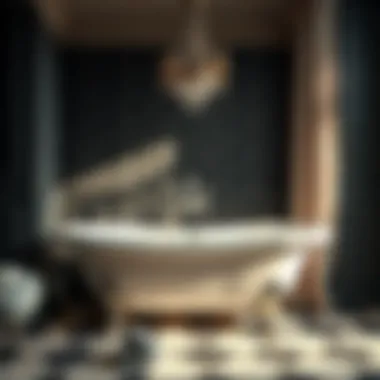
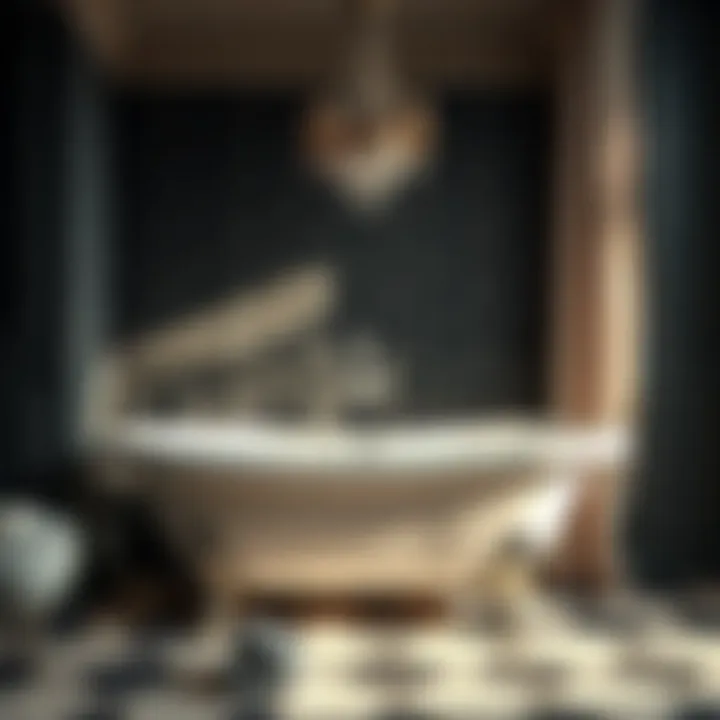
Delving into the expert crowd reveals diverse opinions on how often a bathtub should be refinished. Generally, the consensus leans toward a period of 3 to 10 years between refinishing jobs, depending on various factors. This frequency allows for the preservation of the tub while ensuring it remains visually appealing and functional.
However, experts consider a few compelling factors that might influence this timeline:
- Intensity of Use: A bathtub in a master bathroom, which sees daily use, might need refinishing sooner than one in a guest bathroom that’s used sparingly.
- Quality of Initial Refinishing: If a previous refinishing job was done poorly, it may deteriorate faster and require more frequent attention.
- Environmental Factors: Bathrooms with high humidity or excessive cleaning might also lead to a shorter lifespan of the finish.
Reaching a conclusion means engaging with trusted professionals and not rushing to follow what’s become a trend. Every bathtub tells its own story, and those stories often dictate when it’s time for another revitalization.
Ultimately, investing in expert recommendations is akin to a safety net—offering insights that can help avoid costly mistakes and ensuring that each refinishing effort is a step toward lasting quality.
Signs Your Bathtub Needs Refinishing
Knowing when it’s time to refinish your bathtub is pivotal for maintaining its functionality and visual appeal. Over time, bathtubs endure substantial wear and tear due to daily use. Recognizing the signs that indicate the need for refinishing can save homeowners from more extensive and costly repairs down the line. By understanding these indicators, you can make informed decisions about bathtub maintenance that ensure a safe and pleasant bathing environment.
Visible Signs of Wear
Chips and Cracks
Chips and cracks can easily mar the aesthetic beauty of any bathtub. These imperfections not only detract from the overall look but they can also lead to further damage if not addressed promptly. A chip in the enamel or a crack in the fiberglass can allow water to seep underneath the surface, creating an ideal breeding ground for mold and mildew. Furthermore, these visible flaws can reduce the bathtub's resale value, which is a crucial consideration if you’re thinking about selling your home.
The key characteristic of chips and cracks is their potential for escalation. What starts as a small chip could develop into a more significant issue if not attended to, leading to an expensive replacement rather than a simple refinishing project. Addressing these visible signs early through refinishing can restore the bathtub’s smooth surface and avoid bigger headaches later on.
In this article, chips and cracks are highlighted as a major reason for refinishing awareness because stopping them in their tracks can save more than just expense; it preserves functionality too. Neglecting these imperfections could mean compromising the integrity of your bathtub.
Fading Finish
A fading finish on your bathtub is another noticeable signal that it’s time for refinishing. Over time, exposure to heat, water, and various cleaning chemicals can cause the once bright and shiny surface to appear dull and lifeless. This fading not only affects appearance but can also alter the texture of the bathtub, leading to a more slippery and potentially hazardous surface.
The distinct feature of a fading finish is that it signals a loss of the protective layer that maintains the durability of the bathtub material. Many homeowners don’t realize that refinishing can restore this finish, making it both visually appealing and safer to use. This characteristic makes fading a strong contender for triggering refinishing if you want to ensure that your bathroom portrays the right ambiance.
Being aware of a fading surface is crucial since it often serves as a precursor to more severe issues such as staining or cracking. Refinishing offers the chance to not only restore the bathtub's luster but also extend its lifespan significantly.
Functional Issues
Water Leakage
When a bathtub starts to show signs of water leakage, it's more than just a nuisance; it's a clear indication that the structural integrity may be compromised. Leaks can originate from small fissures that develop over time and can lead to extensive damage, not just to the tub itself but also to the surrounding bathroom. In essence, water leakage can lead to mold growth and even underpinning decay, which are costly to repair.
As a characteristic affecting safety and hygiene, addressing leak issues through refinishing can mitigate potential health hazards and preserve the bathroom's structural integrity. This makes it a priority for any homeowner who wants to maintain a safe living environment. Moreover, by spotting and addressing leaks early, you are often able to prevent an expensive repair bill in the long run.
Surface Roughness
Surface roughness can serve as an uninvited signal that more extensive issues may be at play. When the finish on a bathtub becomes rough, it creates a perfect environment for soap scum and grime to accumulate, making cleaning a hassle. A rough surface can also be uncomfortable to the skin during bathing, leading to an unenjoyable experience.
The distinctive characteristic of roughness on a bathtub makes it clear that refinishing can play a redeeming role. Refinishing restores the smooth, pleasant feel of the surface, making baths more enjoyable while encouraging regular cleaning that helps prevent other issues.
In this article, surface roughness is examined not only for its aesthetic implications but also for practical reasons. A smooth surface is vital for cleanliness and safety—treating it through refinishing addresses both physical comfort and ease of care. Homeowners should be proactive in refinishing their bathtubs to maintain their luxurious feel and look.
Comparing Refinishing to Replacement
When it comes to managing a bathtub, homeowners find themselves at a crossroads between refinishing and replacement. Both options have their merits, yet understanding these in depth is essential for making a prudent decision. Refinishing, while often less costly, can only work so many times before it starts to show signs of wear and tear. Replacing, on the other hand, can be a hefty financial commitment, but it may ultimately offer a longer-term solution. Let’s dive into the nuances of this decision.
Cost Implications
The cost of refinishing a bathtub generally stands as one of its most attractive features. On average, a professional refinishing job can set you back anywhere from $300 to $600. Compare that with a full bathtub replacement that can easily reach $3,000 to $4,000 when you factor in labor and added materials. This stark contrast tempts many homeowners to opt for refinishing initially.
However, it’s critical to weigh short-term savings against long-term value. While refinishing can restore a bathtub’s luster, it’s often not a permanent fix. If refinishing needs to be repeated frequently, those costs can add up quickly. In fact, some homeowners may find themselves spending more over time than they would have spent replacing the tub altogether. Keep in mind factors such as the condition of the tub and the quality of refinishing materials used. A hastily done job may also lead to additional expenses down the road.
Time Involved
Time is yet another factor in the equation. Generally, refinishing a tub can be done in a matter of hours, with most projects wrapped up in one day. For homeowners looking to quickly regain functionality in their bathrooms, this expediency is a significant advantage. However, this speedy process requires waiting for a specific period post-refinishing before the tub can be used—often around 24 to 48 hours.
On the flip side, replacing a bathtub is an entirely different ball game. Depending on the complexity of the installation, you might be looking at several days or even weeks before your bathroom is back in action. This includes tearing out the old tub, plumbing adjustments, and installing the new one. For those who can’t handle the downtime, the swift option of refinishing will likely seem more appealing.
Impact on Home Value
When considering impact on home value, both refinishing and replacement have their own stories to tell. A freshly refinished tub can improve the aesthetics of a bathroom, potentially enhancing the overall property appeal, especially in a buyer’s market. Yet, while a refinishing job can draw eyes, it doesn’t carry the same weight as a new bathtub installation.
New bathtubs often offer better performance, lower maintenance costs, and modern designs that align with current homeowner preferences. If your bathroom is an older model, a replacement can significantly boost your home's market value. Buyers tend to be wary of refinished items—they may question the longevity and quality of the work. Therefore, if you're considering selling your home, a full replacement might be a more strategic move to attract potential buyers.


"In the end, the choice between refinishing and replacing boils down to individual needs, budget, and long-term plans for the property."
Establishing a balance between these elements is crucial. Evaluate what fits best with your immediate circumstances and future goals when it comes to your bathtub.
Ultimately, making a well-informed decision about whether to refinish or replace hinges on understanding these different aspects of the project.
Preparing for a Refinishing Project
Prepare yourself for a refinishing project can make a world of difference in both the outcome and longevity of your bathtub’s new finish. When you don’t approach this task with thought and care, you risk a subpar result that may not last as long as you expect. Laying the groundwork correctly also saves time and money in the long run, ensuring you won't need to redo the work sooner than necessary.
Choosing a Service Provider
When it comes down to refinishing your bathtub, one of the most pivotal decisions you'll make is selecting a service provider. Not all refinishing experts are created equal. Finding qualified contractors who have both experience and a solid reputation is essential. A contractor's expertise directly influences the quality of the job.
Finding Qualified Contractors
How does one find these shining stars among service providers? Firstly, focus on gathering recommendations from friends, neighbors, or online homeowner groups. An excellent way to spot the good ones is through their reviews on platforms like Yelp or Google Reviews. A contractor's key characteristic should not only be their technical skill but also a positive customer feedback loop. Different from DIY approaches, where results can be hit or miss, skilled professionals offer a reliable guarantee for their work. They often employ specialized materials and techniques designed to extend the life of the finish.
However, choosing a reputable contractor can sometimes come with its downsides. For instance, their fees may be higher than a DIY refinishing process, but in the end, your bath might remain intact for years to come, justifying that investment.
Reviewing Past Work
While the contractor’s experience is crucial, reviewing past work is just as important. This practice helps you visualize what to expect from their services. Proper homeowners take the time to look at before-and-after pictures, preferably from previous clients. This not only assures you of the quality of work but also showcases the contractor’s style and attention to detail.
One appealing feature of this practice is the ability to reference specific issues that might arise during your own project. Have they successfully dealt with chips or stains in past bathtubs? This kind of insight can guide your decision-making process tremendously. On the flip side, this approach might require a bit more time and can feel overwhelming at first. A thorough review can eliminate the bad choices before you make one, ultimately leading to a more satisfying refinishing outcome.
DIY Refinishing Considerations
For those who lean towards a DIY method for bathtub refinishing, several aspects warrant careful consideration. While it may seem like a cost-effective approach, proper preparation and understanding of materials are crucial. You’ll need to gather supplies such as special paints, protective gear, and cleaning agents. Moreover, creating a controlled environment ensures that your project stays clean and the weather does not interfere with the curing process.
Although DIY refinishing can save you cash, it also poses certain risks, such as uneven finishing or premature wear. So weigh the pros and cons carefully before you dive in. Be sure to arm yourself with as much information as possible to tackle this challenge effectively.
Ensuring Longevity Post-Refinishing
After putting in the time and money to refinish a bathtub, it’s essential to understand how to keep that fresh, appealing look. Ensuring longevity post-refinishing not only preserves the aesthetic value of your bathtub but also maximizes your investment. With the right care regime, homeowners can avoid early deterioration.
One key aspect is adopting proper cleaning practices. For refining treatments to hold up well against wear and tear, gentle cleaning solutions should be prioritized. Avoiding abrasive pads and harsh scrubs can prevent scratching the surface. Microfiber cloths serve as a great alternative for their soft texture; they provide effective cleaning without damage.
Another important point is the environmental conditions in which the tub resides. Fluctuations in humidity and constant exposure to water can affect the longevity of a refinished tub. Hence, maintaining a stable environment, such as using exhaust fans during and after showers, can help prevent unnecessary moisture build-up. This practice can be crucial in keeping your newly refinished surface intact.
"Treat your tub as a cherished part of your home; it deserves care to elongate its life and appeal."
Recommended Care Practices
To maximize the life of your refinished bathtub, consider the following best practices:
- Use gentle cleansers: Look for pH-balanced solutions that won’t wear away the refinishing. Solutions like diluted vinegar can serve as effective yet gentle cleaners.
- Shower mats are your friend: Using non-slip mats can help prevent scratches or wear from bath items. Be sure to select mats designed for use in refinished tubs.
- Routine maintenance checks: Regularly checking for signs of wear allows for early intervention. If you spot a small chip or crack, addressing it right away can save you from a bigger problem down the line.
- Limit exposure to hot water: High temperatures can weaken refinished surfaces over time, making moderate warmth more advisable.
By implementing these simple but effective practices, homeowners can greatly enhance the lifespan of their refinished bathtubs.
Products to Avoid
When caring for your bathtub, it's equally crucial to know what products to steer clear of. Using the wrong cleaners can cause significant damage to a refinished surface:
- Abrasive cleaners: Products like scouring powders or gritty scrubs. They may promise to clean effectively but can mar the finish.
- Acidic substances: Cleaners strong in acid, like some bathroom cleaners, can etch the newly refinished surface and lead to deterioration.
- Bleach: While it’s a common household cleaner, bleach can wreak havoc on the finish, leading to discoloration.
- Natural stone cleaners: These often contain chemicals unsuitable for refinished surfaces.
Pay attention to ingredient labels and select products that promote longevity rather than dealing a blow to your investment. By opting for safe, suitable products, you'll maximize the appearance and functionality of your bathtub, keeping it the beautiful centerpiece of your bathroom for longer.
Ending
In wrapping up our discussion on bathtub refinishing, it’s vital to consider not just the practicalities, but also the broader implications of this maintenance undertaking. Refinishing can extend the life of your bathtub significantly, but understanding the limitations is crucial if you’re aiming for long-term satisfaction without compromising quality.
Assessing Lifespan and Frequency
The lifespans of various bathtub materials can dictate how often refinishing can realistically occur. A porcelain tub, for example, might withstand two to three refinishing jobs, thanks to its sturdy nature. On the other hand, fiberglass can be more delicate; refinishing too often could jeopardize its original integrity. This means that house owners need to weigh their options carefully, assessing the actual condition of their bathtub before jumping into a refinishing project.
Practical Best Practices
It isn't just about how many times you can refinish. The quality of the initial refinishing plays a significant role in determining future cycles. Professional refinishing often yields a more durable finish compared to DIY approaches. Moreover, your daily habits—how you clean and maintain your tub—can either prolong or diminish the effects of refinishing. Simple practices, like using softer cleaning agents rather than harsh chemicals, can make a world of difference in how long your refinishing job lasts.
The Importance of Professional Guidance
Consulting professionals can illuminate many aspects that might not be immediately obvious. Industry experts often provide insights on how many times a bathtub can be refinished based on specific conditions unique to each home. By following their recommendations and adhering to maintenance practices, homeowners can avoid costly mistakes down the line.
Choosing to refinish a bathtub should never be a hasty decision; it’s an investment in your home’s comfort and aesthetics.



